I readily admit that many of the garden’s successes are more a result of complete accident rather than efforts on my part. Certainly, some benefit is derived from good planning. Occasionally, combinations of colors and textures work out just as envisioned, but more satisfying are unanticipated pleasures that have nothing at all to do with the garden’s design.
For whatever reason, a year ago I planted ‘Homestead Purple’ verbena in a spot of new ground that begged for a temporary filler, though it is bit bright for my taste. ‘Homestead’ is rarely fully perennial, but even after a colder than average winter a few areas where stems of the verbena rooted have returned to grow and flower vigorously. Its aggressive nature must be monitored or it will overwhelm neighbors, but in this sunny spot it is most useful in attracting the hummingbird moth, a particular favorite of mine. Seemingly a hybrid of hummingbird and bumblebee, the moth blissfully ignores my presence to extract nectar from every bloom on the verbena as I crouch nearby, mesmerized.

The heat of this early summer has only occasionally been brutal, and while it is certain that the worst is still to come, the gardener is satisfied that the disasters created by the severe winter have mostly been made tolerable. Dead shrubs have been chopped out, and branches have been cut away so that injuries from cold have been masked by vigorous growth. Hydrangeas and paperbushes (Edgeworthia chrysantha) that were cut to a fraction have recovered, though not quite to their former selves.
Concern remains that the Franklinia (Franklinia alatamaha, above) planted at the high side of a wet weather spring has progressively declined, in a similar fashion to the neighboring ‘Arnold Promise’ witch hazel (Hamamelis x intermedia ‘Arnold Promise) that was recently removed due to persistent dampness. In recent years, several branches have been pruned from the twenty year old Franklin tree, but I fear this has not slowed its decline. Now, leaves are small and too widely scattered, and I suspect by spring it will be gone.
In talking with gardeners, it seems a rarity for Franklinia to live for two decades. This fortunate tree was initially from a group of twenty-five that was dug from a nursery in late winter, and became the lone survivor of trees that are notoriously difficult to transplant. Until the last few years it grew with few problems, but now it seems I must prepare for what seems its inevitable loss (and with no suitable Franklinias available). Instead, I’ve planted two Gordlinias (xGordlinia grandiflora, above), shrubby hybrids of the Franklinia and southern Gordonia. These have been planted on higher and drier ground, and though the two have suffered minor injuries through their first two winters, both appear to have turned the corner with vigorous growth.
The gordlinias have flowers and foliage similar to Franklinia, and if references are correct these shrubby trees might be more sturdy than the short lived Franklinia. Their relation to significant botanists and historical figures is not so interesting (see Wikipedia), but the blooms and autumn foliage color will recall the treasured Franklin tree long after its loss.
In the damp swale where the witch hazel and Franklinia have suffered, buttonbush (Cephalanthus occidentalis, above) and bottlebrush buckeye (Aesculus parviflora, below) thrive in the soggy ground. I first noted buttonbush in swampy ground along a hiking trail my wife and I frequent. The ping pong ball sized white orbs were visited by dozens of varied pollinators, and though the foliage was unexceptional, this seemed perfectly suited to the increasingly damp area in my garden. Three lanky shrubs have flourished in the muck and standing water, and bees and other pollinators have found their way to visit. 
The bottlebrush buckeye involved less planning and no effort since it was a volunteer seedling. I take credit for its presence only in that I avoided weeding this area for long enough that the large, compound leaves of the shrub became evident. Beneath a wide spreading river birch (Betula nigra) it grows slowly, and has fewer blooms than in a sunnier space, but it is as treasured as any shrub or tree in the garden.
Sad to see a decline of wonderful plant!
Though I’m not giving up yet on the Franklinia this has been my most distressing spring. Two magnolias and the large ‘Arnold Promise’ witch hazel have perished, and probably another handful of smaller treasures have died that I’ve gotten over already. So many plants were injured, only to recover late in the spring, but this has allowed some new additions that keep the spirits high.
Good luck!